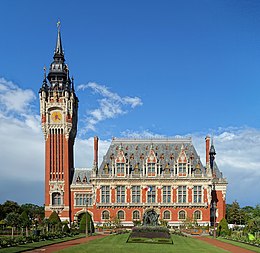Hôtel de Ville de Calais is the seat of the city council in Calais, France. It has a 72-metre belfry of red brick and white limestone.
| UNESCO World Heritage Site | |
|---|---|
 Hôtel de Ville, Calais | |
| Location | Calais, France |
| Part of | Belfries of Belgium and France |
| Criteria | Cultural: (ii), (iv) |
| Reference | 943-048 |
| Inscription | 1999 (23rd Session) |
| Extensions | 2005 |
| Area | 0.182 ha (0.45 acres) |
| Buffer zone | 700 ha (1,700 acres) |
| Coordinates | 50°57′09″N 1°51′16″E / 50.95263°N 1.85452°E |
History
editIn 1885, Old Calais, which centred round Église Note Dame on the north side of the Canal de Calais, merged with Saint-Pierre, which centred round Église Saint-Pierre on the south side of the Canal de Calais.[1] This led to calls for a new Hôtel de Ville to serve both districts. The site the council selected was in the area between the two towns.[2]
Work on the new building stated in 1912, but was temporarily paused during the First World War. It was designed by Louis Debrouwer of Dunkirk in the Renaissance Revival and Flemish styles, built in red brick and white limestone and was completed in 1925.[3]
In 2003, it was designated a monument historique by the French state.[4] In 2005, its belfry was added to the UNESCO World Heritage Site ensemble of the Belfries of Belgium and France.[5]
Les bourgeois de Calais ("The Burghers of Calais") is a sculpture by Auguste Rodin, commissioned by the city and standing in front of the city hall. It depicts the six leading citizens who were taken by Edward III of England after the Siege of Calais (1346–1347) during the Hundred Years' War.[6]
References
edit- ^ Cave, Nigel (1990). Battleground Europe A Guide to Battlefields in France & Flanders. Pen and Sword Books. p. 19. ISBN 978-1783832934.
- ^ "Map of Calais". Johannes Wilhelm Liebenow. Retrieved 7 October 2024.
- ^ "Louis Debrouwer, the audacious architect of Calais town hall". Daily Nord. 10 August 2015. Retrieved 18 February 2022.
- ^ Base Mérimée: PA62000055, Ministère français de la Culture. (in French)
- ^ "Belfries of Belgium and France". UNESCO. Retrieved 18 February 2022.
- ^ Guette, Henri (23 May 2017). "Quand Rodin offre à Calais un symbole qui dérange" [When Rodin offered to Calais a symbol that caused uproar]. Beaux Arts (in French). Retrieved 18 February 2022.
